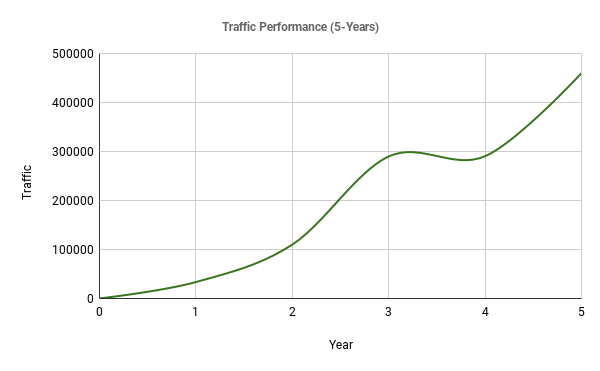
Boost more in-store and online sales with a comprehensive SEO strategy that will bolster visibility of your shop.
We deliver innovative website, SEO, and content strategies – grounded in timeless marketing principles – to help all types of retail shops protect their reputation and get new customers.
The global retail market is projected to reach approximately $31.3 trillion by 2024, driven by technological advancements and increasing consumer demand.
To capitalize on this growth, it’s essential for retailers to establish a robust online presence through a well-designed website and effective SEO strategies. This approach enhances visibility, attracts prospective customers, and ensures your business stands out in an increasingly competitive retail landscape.
A 2024 survey revealed that 99% of American consumers read online reviews before making purchases, with reviews influencing 93% of purchasing decisions. This underscores the critical importance of a strong online presence for retail businesses. Implementing effective SEO strategies can significantly enhance visibility, drive targeted traffic, and convert inquiries into sales.
Why do online and brick-and-mortar retailers need SEO?
Search Engine Optimization (SEO) is essential for retailers aiming to enhance their online presence, attract customers, and boost sales.
By optimizing their websites, retailers can ensure they appear prominently in search engine results, making it easier for consumers to find and engage with their products and locations.
Consumers frequently use search engines to:
- Find Stores and Products: Searching for nearby stores, specific products, or brands online to plan their purchases.
- Evaluate Product and Store Reputation: Reading reviews and testimonials to assess the quality of products, customer service, and overall shopping experience.
- Compare Prices and Options: Looking up different brands and stores to find the best deals and product options.
- Research Product Information: Seeking details about specific products, from specifications to customer feedback, before making a purchase.
- Locate Contact Information or Store Hours: Finding the essential information needed to visit a store, make a call, or shop online.
A strong SEO strategy ensures that a retailer’s website ranks highly in search results, increasing the likelihood that potential customers will find and consider their products. Without effective SEO, retailers may miss valuable opportunities to attract both online and in-store shoppers, leading to decreased visibility and sales.
What does a retailer SEO strategy look like?
Many believe that simply building a website is enough for SEO and to rank well in organic search—but that couldn’t be further from the truth. For retailers, it’s about creating a cohesive online presence (website, social media, reviews, etc.) that works together to increase visibility, attract shoppers, and drive both online and in-store sales.
Here’s how a comprehensive retailer SEO strategy can help:
- Technical SEO: Ensuring your website is technically sound, with fast load times, mobile optimization, and proper indexing by search engines. This is essential for retailers, as consumers need seamless access to product information, whether on desktop or mobile.
- Content Strategy: Creating informative, engaging content that not only drives traffic but also converts visitors into customers. This includes product descriptions, category pages, blog posts on shopping trends, and resources that showcase your expertise and build trust in your brand.
- Local SEO: Making sure your store appears prominently in local search results, so nearby shoppers can easily find you. This includes optimizing your Google Business Profile, local listings, and using geo-targeted keywords to drive foot traffic.
- Reputation Management: Ensuring that when prospective customers search for your store, they see positive reviews and accurate information. Managing and responding to reviews builds credibility and encourages new customers, especially in retail where reputation and customer experience are key.
TechAudits can help you sell more products.
Get started with managed SEO services today.
We help all types of retail businesses improve their reputation, get found via organic search, sell more products and get more foot traffic in their stores.
Fashion & Apparel
Electronics
Home Goods
Beauty / Makeup
Grocery
Sporting Goods
Jewelry
Pets
Thrift Stores
Have questions about working with an SEO company?
We have answers. The team behind TechAudits has been working in or around the education space for the better part of the last 10 years. We have experience working with online marketplaces, jewelry stores and fashion brands, including thrift brands.
We are certain that if you partner up with TechAudits you will see a strong return for all of the effort.
SEO is the practice of optimizing your online presence to enhance visibility in search engine results and attract targeted traffic.
You should expect:
- Sustainable Growth: SEO helps drive qualified, long-term traffic to your site, supporting sustained growth in new customers.
- Targeted Traffic: Reach potential customers actively searching for your products.
- Cost-Effective Marketing: Establishing SEO as a marketing channel provides a strong return on investment compared to other advertising methods.
- Increased Brand Awareness and Credibility: High search rankings help build trust and position your brand as a retail leader in your market.
Search Engine Optimization (SEO) for the retail industry has distinct characteristics that set it apart from other sectors. Key differentiators include:
Product-Centric Keywords: Retail SEO focuses on optimizing for specific product names, categories, and attributes to capture consumers actively searching for particular items. This contrasts with service-based industries, which often target broader service-related terms.
E-commerce Integration: Retailers frequently operate online stores, necessitating SEO strategies that enhance product page visibility, optimize for shopping-related queries, and improve the overall user experience to drive conversions.
Seasonal Trends: The retail sector experiences significant fluctuations due to seasonal events, holidays, and sales periods. SEO efforts must adapt to these trends, optimizing content and promotions to align with consumer demand cycles.
Visual Content Optimization: High-quality images and videos are crucial in retail to showcase products effectively. Optimizing visual content for search engines, including proper use of alt tags and image compression, is essential to enhance visibility and load times.
Local and Mobile Optimization: For brick-and-mortar retailers, local SEO is vital to attract nearby customers. Additionally, with a significant portion of retail searches occurring on mobile devices, ensuring mobile-friendly website design and functionality is critical.
By addressing these unique aspects, retailers can develop SEO strategies that effectively enhance online visibility, attract targeted traffic, and drive sales.
Reputation management is crucial for retailers due to several key factors:
Consumer Trust and Credibility: A positive reputation fosters trust among consumers, significantly influencing their purchasing decisions. In the retail sector, where numerous options are available, shoppers are more likely to choose brands they perceive as reputable and reliable.
Online Presence and Reviews: With a substantial number of consumers researching products and services online before making purchases, maintaining a favorable digital image is essential. Positive reviews and testimonials enhance a retailer’s visibility and attractiveness to potential customers.
Competitive Advantage: In a highly competitive market, a strong reputation differentiates a retailer from its competitors. A well-managed reputation can lead to increased customer loyalty and higher sales, providing a significant edge in the marketplace.
Customer Retention and Referrals: Satisfied customers are more likely to return and recommend the retailer to others. A solid reputation contributes to ongoing growth through repeat business and word-of-mouth referrals.
Crisis Management: Effective reputation management enables retailers to address negative feedback promptly, mitigating potential damage and demonstrating a commitment to customer satisfaction and transparency.
By actively managing their reputation, retailers can build trust, enhance their market position, and ensure long-term success in customer acquisition and retention.
Your optimization efforts will pay off, but the results may not be immediately visible. While you might notice some initial progress within a couple of months, significant changes — like climbing up the search rankings — often takes around three to six months.
Developing a robust SEO strategy is essential for retailers aiming to enhance their online visibility and drive both online and in-store sales. Key focus areas include:
Keyword Research: Identify terms that potential customers use when searching for your products. This involves targeting both broad and long-tail keywords to capture various search intents, from general product inquiries to specific brand or model searches.
On-Page Optimization: Ensure that each webpage is optimized with relevant keywords in title tags, meta descriptions, headers, and content. This enhances search engine understanding and improves user experience, making it easier for customers to find and navigate your site.
Technical SEO: Address technical aspects such as site speed, mobile responsiveness, secure connections (HTTPS), and proper indexing. A technically sound website ensures that search engines can crawl and index your pages effectively, leading to better rankings.
Content Strategy: Create high-quality, engaging content that provides value to your audience. This includes product descriptions, blog posts, buying guides, and multimedia content that can attract and retain customers, encouraging them to make informed purchasing decisions.
Local SEO: Optimize your online presence to attract local customers. This involves managing your Google Business Profile, ensuring consistent NAP (Name, Address, Phone Number) information across directories, and encouraging customer reviews to boost local search visibility.
Link Building: Acquire high-quality backlinks from reputable websites to enhance your site’s authority. This can be achieved through partnerships, sponsorships, guest blogging, and creating shareable content that others want to link to.
User Experience (UX): Focus on providing a seamless and enjoyable experience for users. This includes intuitive navigation, fast load times, clear calls-to-action, and a responsive design that adapts to various devices, all of which can lead to higher engagement and conversions.
Analytics and Performance Tracking: Utilize tools like Google Analytics and Google Search Console to monitor key performance indicators (KPIs) such as organic traffic, bounce rates, conversion rates, and keyword rankings. Regular analysis allows for data-driven decisions and continuous optimization of your SEO strategy.
By focusing on these areas, retailers can develop a comprehensive SEO strategy that enhances online visibility, attracts targeted traffic, and drives sales both online and in physical stores.
Measuring the success of a retail SEO campaign involves tracking key performance indicators (KPIs) that reflect improvements in online visibility, user engagement, and sales conversions. Essential metrics to monitor include:
Organic Traffic: Evaluate the number of visitors arriving at your website through unpaid search results. An increase in organic traffic indicates enhanced visibility and effective keyword targeting.
Keyword Rankings: Monitor your website’s positions in search engine results pages (SERPs) for targeted keywords. Improved rankings suggest successful optimization efforts and greater potential for attracting relevant traffic.
Click-Through Rate (CTR): Assess the percentage of users who click on your website link after seeing it in search results. A higher CTR indicates that your meta titles and descriptions are compelling and relevant to search queries.
Conversion Rate: Measure the proportion of website visitors who complete desired actions, such as making a purchase or signing up for a newsletter. An increasing conversion rate signifies that your site effectively engages visitors and encourages transactions.
Bounce Rate: Track the percentage of visitors who leave your site after viewing only one page. A high bounce rate may indicate issues with site content, user experience, or page relevance.
Average Session Duration: Monitor the average time users spend on your website. Longer sessions typically reflect engaging content and a positive user experience.
Pages per Session: Evaluate the average number of pages viewed during a single visit. More pages per session can indicate effective internal linking and engaging content that encourages exploration.
Return on Investment (ROI): Calculate the financial return generated from your SEO efforts relative to the costs incurred. A positive ROI demonstrates the profitability and effectiveness of your SEO strategy.
Regularly analyzing these metrics provides valuable insights into the performance of your retail SEO campaign, enabling data-driven decisions to optimize strategies and achieve business objectives.
TechAudits has helped many brands establish their place in organic results, both local and national.
See how TechAudits has driven significant revenue and value for our clients by checking out our case studies.
Read Case Studies